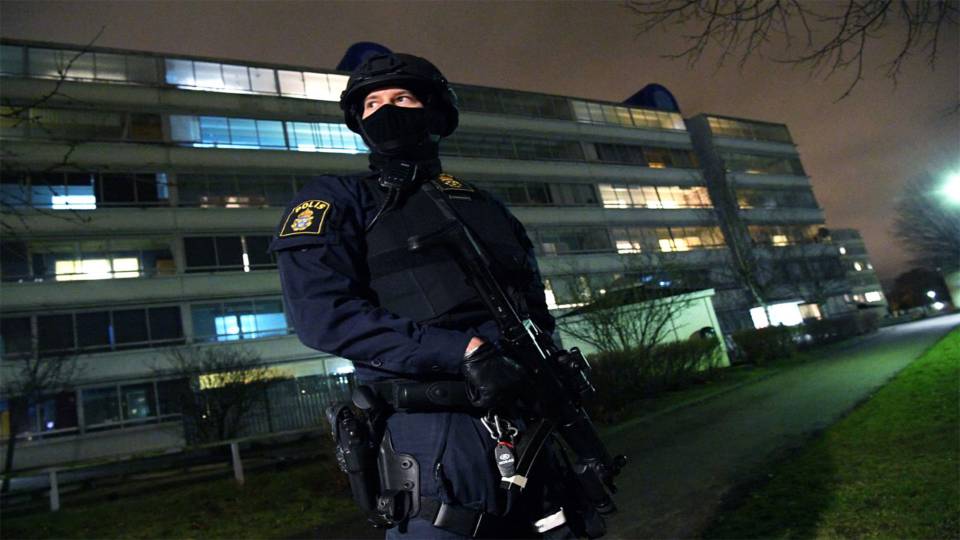Sweden’s Violent Reality Is Undoing a Peaceful Self-Image
Sweden may be known for its popular music, IKEA and a generous welfare state. It is also increasingly associated with a rising number of Islamic State recruits, bombings and hand grenade attacks.
Shootings have become so common that they don’t make top headlines anymore.
In a period of two weeks earlier this year, five explosions took place in the country. It’s not unusual these days — Swedes have grown accustomed to headlines of violent crime, witness intimidation and gangland executions. In a country long renowned for its safety, voters cite “law and order” as the most important issue ahead of the general election in September.
The topic of crime is sensitive, however, and debate about the issue in the consensus-oriented Scandinavian society is restricted by taboos.
To understand crime in Sweden, it’s important to note that Sweden has benefited from the West’s broad decline in deadly violence, particularly when it comes to spontaneous violence and alcohol-related killings. The overall drop in homicides has been, however, far smaller in Sweden than in neighboring countries.
Gang-related gun murders, now mainly a phenomenon among men with immigrant backgrounds in the country’s parallel societies, increased from 4 per year in the early 1990s to around 40 last year. Because of this, Sweden has gone from being a low-crime country to having homicide rates significantly above the Western European average. Social unrest, with car torchings, attacks on first responders and even riots, is a recurring phenomenon.
Shootings in the country have become so common that they don’t make top headlines anymore, unless they are spectacular or lead to fatalities. News of attacks are quickly replaced with headlines about sports events and celebrities, as readers have become desensitized to the violence. A generation ago, bombings against the police and riots were extremely rare events. Today, reading about such incidents is considered part of daily life.
The rising levels of violence have not gone unnoticed by Sweden’s Scandinavian neighbors. Norwegians commonly use the phrase “Swedish conditions” to describe crime and social unrest. The view from Denmark was made clear when former President of NATO and Danish Prime Minister Anders Fogh Rasmussen said in an interview on Swedish TV: “I often use Sweden as a deterring example.”
In response, the Swedish government has launched an international campaign for “the image of Sweden” playing down the rise in crime, both in its media strategy and through tax-funded PR campaigns. During a visit to the White House in March, Sweden’s Prime Minister Stefan Löfven admitted that his country has problems with crime and specifically shootings, but denied the existence of no-go zones. Sweden’s education minister, Gustav Fridolin, traveled to Hungary last week with the same message.
But the reality is different for those on the ground: The head of the paramedics’ union Ambulansförbundet, Gordon Grattidge, and his predecessor Henrik Johansson recently told me in an interview that some neighborhoods are definitely no-go for ambulance drivers — at least without police protection.
Swedes are not prone to grandiose manifestations of national pride, but the notion of a “Swedish Model” — that the country has much to teach the world — is a vital part of the national self image.
Since crime is intimately linked to the country’s failure to integrate its immigrants, the rise in violence is a sensitive subject. When the Swedish government and opposition refer to the country as a “humanitarian superpower” because it opened its doors to more immigrants per capita during the migrant crisis than any other EU country, they mean it. This has resulted in some impressive contortions.
In March, Labor Market Minister Ylva Johansson appeared on the BBC, where she claimed that the number of reported rapes and sexual harassment cases “is going down and going down and going down.” In fact, the opposite is true, which Johansson later admitted in an apology.
Similarly, in an op-ed for the Washington Post, former Prime Minister Carl Bildt described the country’s immigration policy as a success story. He did not elaborate on violent crime. After repeated attacks against Jewish institutions in December — including the firebombing of a synagogue in Gothenburg — Bildt took to the same paper to claim that anti-Semitism is not a major problem in Sweden.
“Historically, in Sweden it was the Catholics that were seen as the dangerous threat that had to be fought and restricted,” Bildt claimed, seemingly unaware that the laws he cited also applied to Jews. Intermarriage was illegal and hostility was based on ideas of Jews as racially inferior. Bildt’s attempt to relativize current anti-Semitism with odd and inaccurate historical arguments reflects how nervously Swedish elites react to negative headlines about their country.
Another spectacular example is an official government website on “Facts about migration, integration and crime in Sweden,” which alleges to debunk myths about the country. One “false claim” listed by the government is that “Not long ago, Sweden saw its first Islamic terrorist attack.”
This is surprising, since the Uzbek jihadist Rakhmat Akilov has pleaded guilty to the truck ramming that killed five people in Stockholm last April and swore allegiance to the Islamic State prior to the attack. Akilov, who is currently standing trial, has proudly repeated his support for ISIS and stated that his motive was to kill Swedish citizens. He also had documented contacts with international jihadis.
The government’s excuse for denying the Islamic terrorist attack in Sweden is that no Islamic group has officially claimed responsibility. Given the importance these days of fighting fake news, the Swedish government’s tampering with politically inconvenient facts looks particularly irresponsible.
Sometimes it takes an outsider to put things in perspective. A recent piece by Bojan Pancevski in London’s Sunday Times put a spotlight on immigration and violent crime. The article caused a scandal in Sweden and was widely seen as part of the reason why the British and Canadian foreign ministries issued travel advice about the country, citing gang crime and explosions. “They make it sound as if violence is out of control,” said Stefan Sintéus, Malmö’s chief of police.
It didn’t seem to occur to the police chief that both the travel advice and the article could reflect the same underlying reality. After all, only a few days earlier, a police station in Malmö was rocked by a hand grenade attack. Earlier the same month, a police car in the city was destroyed in an explosion.
Officials may be resigned to the situation. But in a Western European country in peacetime, it is reasonable to view such levels of violence as out of control.






















